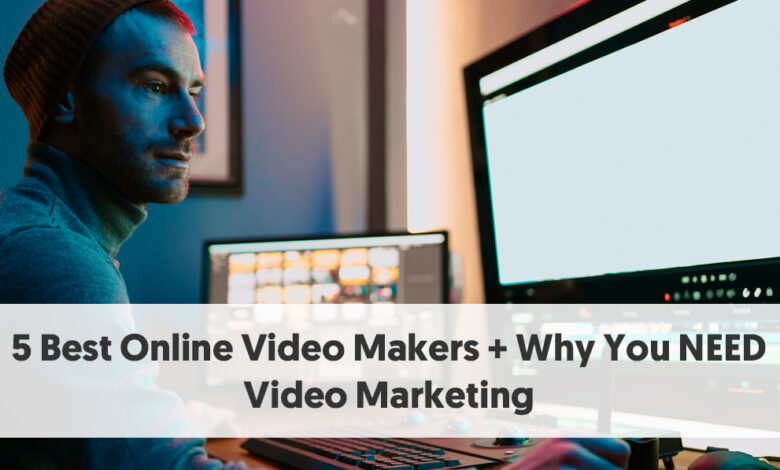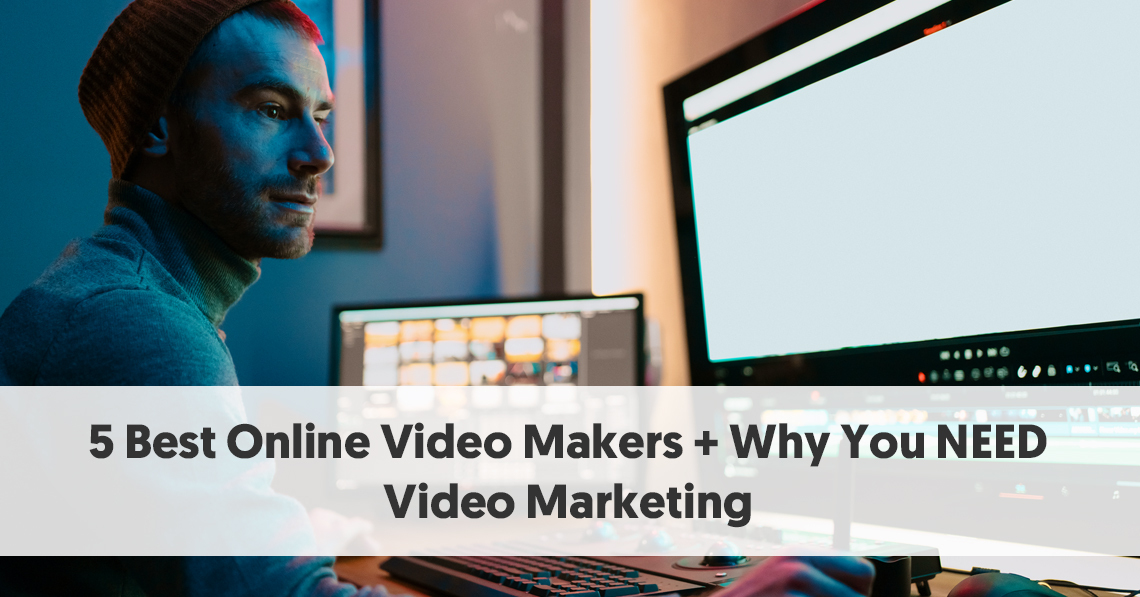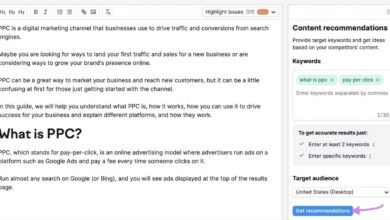
Online Video Marketing A Comprehensive Guide
Online video marketing is exploding in popularity, and for good reason. It’s no longer just a trend; it’s a crucial element of any successful modern marketing strategy. This guide dives deep into the world of online video, exploring everything from crafting compelling content to measuring your ROI.
From understanding the nuances of different video formats (short-form, long-form, live streams) to mastering platform-specific strategies on YouTube, TikTok, and Instagram, we’ll cover it all. We’ll explore the essential planning and strategy required to develop a successful online video marketing plan, including identifying KPIs, analyzing your target audience, and creating a content calendar. We’ll also delve into the art of content creation, from brainstorming video ideas to mastering video editing software.
Finally, we’ll examine crucial distribution and promotion strategies, measuring and analyzing results, and understanding emerging trends like AI and VR in video marketing.
Introduction to Online Video Marketing
Online video marketing is a dynamic and rapidly evolving approach to promoting products and services through video content distributed across various online platforms. It leverages the power of video to engage audiences, build brand awareness, and drive conversions. From captivating short-form clips to informative long-form tutorials, online video marketing offers a multitude of formats tailored to different marketing goals.Traditional video marketing, often limited to television commercials and print ads featuring video clips, contrasts significantly with the broad reach and interactive nature of online video marketing.
Online video marketing allows for real-time engagement, targeted advertising, and a continuous cycle of content creation and optimization for improved performance.
Defining Online Video Marketing
Online video marketing encompasses the creation, distribution, and promotion of video content across the internet. This includes platforms like YouTube, social media channels, websites, and dedicated video-sharing sites. Its aim is to connect with audiences, build brand recognition, and ultimately achieve business objectives through the engaging medium of video.
Key Differences from Traditional Video Marketing
Online video marketing differs significantly from its traditional counterpart in several crucial aspects. Traditional methods often rely on one-way communication, while online video marketing facilitates two-way interaction through comments, likes, shares, and direct messaging. The online environment allows for greater targeting and measurement of campaign effectiveness. Traditional video advertising typically has a fixed broadcast schedule, whereas online video marketing can be optimized in real-time based on viewer engagement and analytics.
Furthermore, online video marketing offers more flexibility in content creation, allowing for a wider range of formats and styles to suit different marketing goals.
Evolving Landscape of Online Video Consumption, Online video marketing
Online video consumption is experiencing exponential growth, with more people than ever turning to video as their primary source of information and entertainment. This shift necessitates a reevaluation of marketing strategies. Video consumption patterns vary across demographics and platforms, requiring marketers to tailor their content to specific audiences and channels. Platforms like TikTok and Instagram Reels have driven a surge in short-form video consumption, necessitating marketers to adapt their content to these shorter attention spans.
The increasing availability of high-speed internet and mobile devices further fuels this trend, making video a more accessible and convenient way to engage with brands.
Successful Online Video Marketing Campaigns
Numerous successful campaigns showcase the power of online video marketing. For example, Dove’s “Real Beauty” campaign on YouTube effectively used emotional storytelling to connect with viewers and promote a positive brand image. Similarly, Chipotle’s humorous and informative videos on social media platforms have effectively increased brand awareness and engagement. These examples demonstrate how authentic storytelling, coupled with a strong understanding of the target audience, can yield substantial results in online video marketing.
Video Formats in Online Marketing
Different video formats cater to diverse marketing objectives and audience preferences. Understanding these variations is crucial for crafting effective campaigns.
| Video Format | Description | Examples |
|---|---|---|
| Short-form | Brief video clips, typically under 60 seconds, optimized for mobile viewing. | TikTok videos, Instagram Reels, YouTube Shorts |
| Long-form | Comprehensive videos lasting over 10 minutes, often used for tutorials, explainers, or in-depth product demonstrations. | YouTube tutorials, product reviews, webinars |
| Live Streams | Real-time video broadcasts, often used for Q&A sessions, product launches, or interactive events. | Facebook Live, Instagram Live, YouTube Live |
Planning and Strategy for Online Video Marketing
Online video marketing is no longer a trend; it’s a necessity. Understanding how to plan and execute a successful video marketing strategy is crucial for reaching your target audience and achieving your business objectives. This approach requires careful consideration of various factors, from content creation to platform selection, all aimed at maximizing engagement and ROI.A well-defined online video marketing plan acts as a roadmap, guiding you through the process of creating compelling video content and distributing it effectively across the right channels.
This strategy ensures your videos resonate with your target audience and drive meaningful results.
Essential Steps in Developing a Comprehensive Online Video Marketing Plan
A robust video marketing plan requires meticulous planning. It starts with identifying clear objectives and outlining specific actions to achieve them. This meticulous process should include detailed steps for production, distribution, and measurement.
- Define clear objectives:
- Identify your target audience:
- Develop a content calendar:
- Select appropriate video marketing platforms:
- Measure and analyze results:
Establish specific, measurable, achievable, relevant, and time-bound (SMART) goals for your video marketing campaign. Examples include increasing brand awareness, generating leads, driving sales, or boosting website traffic. Quantifiable goals like “increase website traffic by 20% in Q3” are preferable to vague objectives.
Understanding your ideal customer is paramount. Analyze demographics, psychographics, interests, and online behavior to tailor your video content to resonate with their needs and preferences. Knowing your audience is critical for creating content that they’ll engage with.
A content calendar provides a structured approach to planning and scheduling video content. It helps maintain a consistent posting schedule, ensuring a steady stream of engaging video content for your audience. A well-organized content calendar will allow you to anticipate and meet the needs of your audience.
Choose platforms where your target audience spends their time. Thorough research and analysis will help you identify the most effective channels to reach your desired demographic.
Track key performance indicators (KPIs) to evaluate the effectiveness of your campaigns. Regular analysis allows for adjustments to improve future campaigns and maximize return on investment.
Key Performance Indicators (KPIs) for Measuring Effectiveness
Tracking the performance of your video marketing campaigns is essential for understanding what’s working and what needs improvement.
- Views and watch time:
- Engagement metrics (likes, comments, shares):
- Conversion rates:
- Click-through rates (CTRs):
These metrics reveal the overall engagement with your videos. High view counts and watch time indicate that your content resonates with the audience.
These metrics provide insights into how your audience interacts with your videos. A high number of likes, comments, and shares signifies that your content is valuable and engaging.
Online video marketing is a powerful tool, but reaching the right audience can be tricky. That’s where innovative agencies like innovative smm agencies for mobile app developers come in. They understand the nuances of mobile app marketing and can help you craft targeted video campaigns that resonate with your specific audience, ultimately boosting your app’s visibility and user engagement.
This leads to greater success in the overall online video marketing strategy.
Track the number of viewers who complete desired actions, such as signing up for a newsletter, making a purchase, or visiting a website. This metric directly measures the effectiveness of your video marketing in driving desired outcomes.
If your videos include calls to action (CTAs), track the CTR to measure how well your videos encourage viewers to click on links or take other actions.
Target Audience Analysis in Creating Engaging Video Content
Understanding your target audience is critical for creating content that resonates with them. This analysis helps you tailor video content to meet their specific needs and preferences.
- Demographic analysis:
- Psychographic analysis:
- Online behavior analysis:
Gather information about age, gender, location, and other demographic data. Consider the psychographic aspects, like values, interests, and lifestyle choices.
Understanding the motivations, beliefs, and attitudes of your target audience is vital. This analysis allows for creating content that aligns with their values and interests.
Analyze their online presence to understand their preferences and engagement with different platforms.
Framework for Creating a Content Calendar Focused on Online Video
A content calendar is a crucial tool for managing and scheduling your video content. It helps ensure consistent posting and allows you to plan ahead.
- Content planning:
- Scheduling and posting:
- Performance tracking:
Determine the type of videos you’ll create, focusing on the topics and formats that will resonate with your target audience.
Establish a posting schedule to maintain consistency and ensure your videos are seen by your audience.
Monitor the performance of each video and adjust your strategy based on the results.
Different Video Marketing Strategies
Various video formats can be employed for different purposes.
- Product demos:
- Tutorials:
- Behind-the-scenes content:
Showcase your products or services through engaging demonstrations.
Offer valuable knowledge by creating step-by-step tutorials.
Build trust and transparency by offering a glimpse into your company culture and processes.
Comparison of Video Marketing Platforms
Different platforms cater to different audiences and purposes.
| Platform | Strengths | Weaknesses |
|---|---|---|
| YouTube | Vast reach, diverse content formats, strong search engine optimization () | Can be challenging to stand out in a crowded marketplace |
| TikTok | High engagement, short-form video format, excellent for viral content | Limited space for in-depth information |
| Visual-centric platform, integrated with other social media channels | Focus on aesthetics, might not be ideal for all types of content |
Content Creation for Online Video Marketing
Crafting compelling video content is crucial for engaging audiences and achieving marketing goals. This involves more than just recording footage; it requires a strategic approach to brainstorming, production, and optimization. Successful video marketing relies on understanding your target audience and delivering valuable, entertaining content that resonates with them.Understanding your target audience is paramount. Knowing their interests, pain points, and preferred consumption habits allows for tailored video content that speaks directly to their needs.
Online video marketing is a powerful tool, but understanding viewer behavior is key. A crucial aspect to consider is bounce rate, which directly impacts your video’s effectiveness. Knowing how to interpret bounce rate, as explained in this helpful guide on bounce rate marketing explained , can be invaluable. Ultimately, by optimizing your video content and understanding audience engagement, you can significantly improve your online video marketing strategy.
A clear understanding of your target audience helps in brainstorming ideas and ensuring that the final product aligns with the brand’s message.
Brainstorming Engaging Video Ideas
To create videos that capture attention, start by identifying topics that resonate with your target audience. Consider current trends, popular topics, and questions your audience is asking. Brainstorming sessions, whether individual or collaborative, are helpful in generating a wide range of ideas. Use mind maps or lists to jot down concepts and then refine them based on feasibility and alignment with brand objectives.
Look for opportunities to create videos that offer value, entertainment, or solve problems for your target audience.
High-Quality Video Production and Editing
High-quality video production is essential for establishing credibility and capturing viewers’ attention. Invest in good lighting, audio equipment, and a stable camera to ensure professional-looking footage. Effective editing is equally important. Clean, concise edits that maintain viewer interest are crucial for impactful videos. Software like Adobe Premiere Pro, Final Cut Pro, or even free options like DaVinci Resolve, can help in this process.
Remember to choose appropriate music and sound effects to enhance the emotional impact of your video.
Optimizing Videos for Different Platforms and Devices
Different platforms and devices have different viewing habits. Short-form videos might perform better on platforms like TikTok, while longer-form videos might be more suitable for YouTube. Consider the aspect ratio, resolution, and file size when uploading to different platforms. Understanding these differences ensures maximum visibility and engagement. Test various formats and styles to determine which ones resonate best with your target audience.
Also, make sure your videos are optimized for mobile viewing, as a significant portion of your audience will watch your content on mobile devices.
Compelling Video Scripts and Storyboards
Strong scripts and storyboards are the backbone of compelling videos. Scripts should be clear, concise, and engaging, keeping the target audience in mind. Storyboards provide a visual guide for the video’s narrative flow, ensuring a smooth and engaging viewing experience. Use strong visuals and engaging narration to keep viewers engaged and retain their interest throughout the video.
A good storyboard will help in pre-visualizing the final product, which in turn allows for a more efficient editing process.
Using Video Editing Software and Tools
Various video editing software and tools offer different features and functionalities. Adobe Premiere Pro and Final Cut Pro are industry-standards, offering advanced editing tools. For beginners, free or affordable options like DaVinci Resolve or Kapwing are viable alternatives. Learning the basic functionalities of these tools will enable you to create and edit high-quality videos. Experiment with different effects, transitions, and titles to personalize your videos and elevate their visual appeal.
Creating Compelling Video Intros and Outros
Intros and outros are crucial for setting the tone and leaving a lasting impression. Intros should grab attention quickly, while outros should reinforce the key message and encourage viewers to take action. Use captivating visuals, dynamic transitions, and relevant music to make your intros and outros memorable. Maintain brand consistency in both intros and outros to reinforce brand identity and recognition.
Different Video Styles and Formats
| Video Style | Format | Description |
|---|---|---|
| Animation | 2D/3D | Utilizes animation techniques to create visuals. Can be comedic, educational, or abstract, offering a wide range of creative possibilities. |
| Live Action | Interviews, Demonstrations, Product Reviews | Captures real-life events, people, and environments. Excellent for showcasing products, services, or personal stories. |
| Documentary | , Narrative | Presents information in a factual and insightful manner, exploring specific topics or events. Often features interviews and archival footage. |
Different video styles and formats cater to various needs and audiences. Choosing the appropriate style ensures the video aligns with the content and effectively conveys the message to the intended viewers.
Distribution and Promotion of Online Videos
Getting your video content in front of the right audience is crucial for success. Effective distribution strategies go beyond simply uploading a video; they require a multifaceted approach that leverages various platforms and techniques. This involves understanding your target audience, choosing the appropriate channels, and implementing a promotion plan that aligns with your overall marketing objectives.
Social Media Promotion Strategies
Social media platforms are powerful tools for video promotion. Targeting specific demographics and interests within these platforms is essential for reaching potential viewers. Building a strong presence on relevant platforms, engaging with followers, and utilizing relevant hashtags are all vital components of a successful strategy. Consistent posting schedules, interactive content, and influencer collaborations can significantly boost video visibility and engagement.
for Video Discoverability
Optimizing videos for search engines is vital for organic reach. This involves using relevant s in video titles, descriptions, and tags. Creating compelling video descriptions, utilizing video sitemaps, and incorporating transcripts or closed captions enhances accessibility and searchability. A comprehensive strategy helps videos rank higher in search results, driving organic traffic and increasing viewership.
Video Embedding and Landing Pages
Embedding videos directly on websites and landing pages enhances user experience and engagement. This integration allows for seamless viewing and creates a more compelling experience for potential customers. Strategic placement on pages is critical, considering factors like user flow and context. Embedding videos on relevant landing pages or product pages directly relates content to the target audience and increases engagement.
Paid Advertising Campaigns
Paid advertising campaigns can significantly amplify video reach. Utilizing targeted advertising on platforms like YouTube, Facebook, and Instagram can reach specific demographics and interests. A/B testing different ad creatives, targeting options, and bidding strategies is key to optimizing campaign performance. Successful paid advertising campaigns often use compelling visuals, concise messaging, and clear calls to action to drive conversions.
For example, a travel company might use targeted ads on Instagram showcasing stunning travel destinations to attract potential customers.
Online video marketing is a fantastic way to connect with potential customers, but you need to make sure your business information is readily available. To really maximize your reach, it’s crucial to ensure your business details are correct and easily accessible on Google. This includes adding preferred phone numbers and local business hours, which can be done by following these clear steps: how to add preferred phone numbers and local business hours on google.
Having accurate contact information directly on Google helps your video marketing efforts by increasing customer trust and making it easier for them to reach you. This then significantly enhances your online presence and helps convert those video views into paying customers.
Social Media Marketing Strategies for Video Promotion
A well-structured social media strategy is crucial for promoting videos effectively. This involves creating a content calendar, scheduling posts, and responding to comments and messages. Utilizing social media analytics tools provides insights into performance, allowing adjustments to improve engagement and reach.
Comparison of Video Promotion Tools and Platforms
Different video promotion tools and platforms offer varying capabilities and features. Comparing the features, pricing, and target audience of each platform is essential for choosing the right tools. Factors to consider include analytics capabilities, community engagement features, and integration options with other marketing tools. For instance, a small business might find a free social media scheduler more suitable than a paid platform with advanced analytics.
A detailed comparison chart can aid in evaluating options and selecting the best tools for a specific campaign.
| Platform | Features | Pros | Cons |
|---|---|---|---|
| YouTube | Video hosting, search, analytics | Large audience, powerful | Can be competitive |
| Targeted ads, community engagement | Extensive targeting options | May require paid promotion | |
| Visual storytelling, influencer marketing | High visual impact | Limited video length |
Measuring and Analyzing Results of Online Video Marketing
Understanding the effectiveness of your online video marketing efforts is crucial for optimizing future campaigns and maximizing return on investment (ROI). Tracking key metrics allows you to identify what’s working, what’s not, and where adjustments are needed. This stage is about more than just counting views; it’s about understanding the impact your videos have on your audience and business goals.Effective video marketing isn’t just about creating engaging content; it’s about understanding how that content performs.
By meticulously tracking metrics, analyzing data, and adapting strategies, you can refine your approach, ensure a high return on investment, and build a successful video marketing campaign.
Key Performance Indicators (KPIs) for Video Performance
Analyzing video performance hinges on identifying and tracking relevant KPIs. These metrics provide valuable insights into audience engagement and the overall effectiveness of your videos. By monitoring these KPIs, you can pinpoint areas for improvement and optimize future video content.
- Video Views: Track the total number of views, unique viewers, and view duration. These metrics help understand overall reach and viewer interest. High view counts, coupled with substantial watch times, suggest a strong level of audience engagement.
- Engagement Metrics: Focus on metrics like likes, shares, comments, and click-through rates (CTRs) from videos. High engagement numbers indicate that the video resonated with the target audience and prompted a desire for interaction. A lack of engagement signals the need for content adjustments.
- Conversion Rates: Measure the number of viewers who took the desired action after viewing the video, such as signing up for a newsletter, making a purchase, or downloading a resource. This directly relates to the campaign’s ultimate goal. Conversion rates provide a quantifiable measure of video impact on key business outcomes.
Analyzing Video Views, Engagement, and Conversions
This involves using various tools and techniques to interpret data and identify trends. A comprehensive approach involves more than simply noting numbers; it necessitates understanding the context behind those numbers.
- View Duration Analysis: Examine how long viewers watched the video. A significant portion of viewers watching the entire video suggests the video effectively captivated the audience. Conversely, short view durations could point to areas where the video’s interest-grabbing ability needs enhancement.
- Engagement Rate Analysis: Evaluate engagement rates across different video segments or sections. This allows for pinpointing areas where audience interest peaks or wanes. This helps understand which elements resonate best and where viewer interest could be stimulated.
- Conversion Funnel Analysis: Track the journey viewers take after watching a video. Understanding the steps involved in conversions allows you to identify bottlenecks and optimize the video content and calls to action for maximum effectiveness.
Tools for Measuring Online Video Marketing Success
Various tools are available to streamline the process of measuring and analyzing online video marketing performance.
- Video Platform Analytics: Many video hosting platforms (YouTube, Vimeo, etc.) offer built-in analytics that track views, engagement, and other metrics. These tools provide real-time data, allowing for quick identification of trends and adjustments.
- Third-Party Analytics Tools: Tools like Google Analytics, social media analytics dashboards, and dedicated video analytics platforms can provide a more comprehensive view of campaign performance by integrating data from multiple sources.
- Custom Tracking Mechanisms: Implement custom tracking parameters in your video links to gain deeper insights into viewer behavior, including identifying which video viewers ultimately complete a specific action. This granular level of tracking allows for targeted improvements.
A/B Testing Different Video Variations
A/B testing allows you to compare different video variations to understand which performs better. This systematic approach can help optimize various aspects, from visuals to calls to action.
- Identifying Variations: Vary aspects such as visuals, scripts, music, calls to action, and even video length. Consider testing different approaches to identify the most effective version.
- Data-Driven Decision Making: Use the results of A/B tests to inform future video creation and campaign strategies. This iterative approach allows for constant refinement and optimization.
- Iterative Improvement: Testing different variations provides a framework for continuous improvement. This cyclical process allows for adjustments and improvements over time.
Analyzing Audience Feedback and Adapting Strategies
Gathering audience feedback provides valuable insights into video effectiveness.
- Collecting Feedback: Implement mechanisms for collecting feedback, such as surveys, polls, comments sections, or direct communication with viewers. These mechanisms offer direct insights into what viewers liked and disliked.
- Adapting Strategies: Analyze the feedback to identify areas for improvement and adjust video content, targeting, or promotion strategies. This iterative process ensures alignment with audience preferences.
Video Engagement vs. Marketing ROI
The relationship between video engagement and ROI is complex but measurable.
| Video Engagement | Marketing ROI |
|---|---|
| High views, high engagement (likes, shares, comments), high conversion rates | High ROI, strong impact on business goals |
| Low views, low engagement, low conversion rates | Low ROI, limited impact on business goals, potential for significant improvement |
Emerging Trends in Online Video Marketing

The landscape of online video marketing is constantly evolving, driven by technological advancements and shifting audience preferences. This dynamic environment demands marketers to adapt and embrace innovative strategies to maintain relevance and achieve impactful results. Understanding the latest trends empowers businesses to connect with their target audiences effectively and build stronger brand identities.The integration of artificial intelligence (AI) and automation is significantly reshaping video marketing processes, from creation to distribution and analysis.
This automation streamlines workflows, enhances efficiency, and empowers marketers to focus on strategic decision-making.
AI and Automation in Video Marketing
AI is revolutionizing video creation and management by automating tasks like video editing, content generation, and personalized recommendations. Tools leverage machine learning algorithms to analyze viewer data and tailor video content to specific demographics. This personalized approach leads to higher engagement and conversion rates. AI-powered tools also enhance video optimization, enabling marketers to choose the optimal platforms and formats for their content, improving discoverability and reach.
Virtual Reality (VR) and Augmented Reality (AR) in Video Marketing
VR and AR are transforming video marketing by offering immersive experiences that engage viewers in unique and memorable ways. VR allows users to step into virtual environments, creating interactive and detailed experiences, while AR overlays digital elements onto the real world, providing engaging interactions. VR and AR are particularly well-suited for product demonstrations, training simulations, and brand storytelling.
For example, furniture companies can utilize VR to allow customers to visualize how a piece of furniture would look in their home, while a historical society can use AR to overlay historical information onto monuments, enriching the visitor experience.
Interactive Video Experiences
Interactive video experiences, incorporating elements like clickable overlays, quizzes, and polls, foster audience engagement. These interactive elements transform passive viewing into active participation, enhancing viewer retention and knowledge acquisition. Interactive videos are also effective in gathering audience feedback, facilitating better understanding of viewer preferences and expectations. Interactive video content is proving useful in education and training as well.
Short-Form Video Content
Short-form video content, including TikTok, Instagram Reels, and YouTube Shorts, has dramatically impacted marketing strategies. These formats cater to the growing preference for concise and easily digestible content. Marketers are optimizing their strategies to produce engaging short-form video content, capitalizing on the trend’s popularity. Brands are finding success in showcasing their products or services in brief, attention-grabbing formats, and leveraging trends to enhance their message.
Live Streaming for Brand Communities
Live streaming is a powerful tool for building and engaging brand communities. Brands can host live Q&A sessions, product launches, behind-the-scenes glimpses, and interactive discussions. These live interactions foster a sense of community, enhance brand authenticity, and strengthen relationships with followers. Live streaming also allows for real-time feedback, enabling marketers to adapt their strategies based on immediate audience response.
Closing Summary

In conclusion, online video marketing is a dynamic and ever-evolving field. By understanding the principles Artikeld in this guide, you can develop a comprehensive strategy to effectively engage your audience, build brand awareness, and drive conversions. Remember, the key is to stay adaptable, embrace innovation, and continually refine your approach based on data and feedback. The potential of online video to revolutionize your marketing efforts is immense; harness it wisely!





